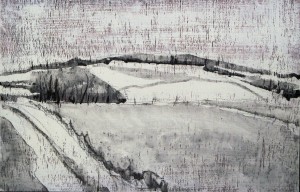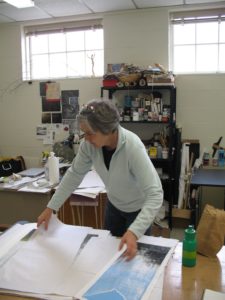Yesterday as I was driving, the BBC was on my radio with more details about the despair of nations. I have not watched the video of a man’s beheading, and I will not. But I have seen enough still shots. And I was hearing on the radio the voice of a mother pleading for another son who is being held captive. These killers have power for a time. What interests me is that they are keeping their heads covered. If they truly believe that what they are doing is right. . . then why are they hiding behind face masks? It would be good to think about that.
This is what I know. God (if He is true, by definition, to His name) is not absent. He is aware and He is moving. The same Master Creator who hovered over chaos many times before and from the beginning, is at work still. I am hearing those stories too, but they don’t make the main press outlets. They will not.
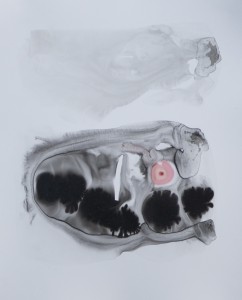 This image, which is the last in a 4 part series (still hanging at the Reece Museum on ETSU’s campus) is a visual glimpse. There are two parts to it’s form: a wispy cloud-like from in the upper horizon, and a more grounded darker mass. Both these forms show movement in one direction, and they are moving together that way. The bottom form is enclosed, and seems to be a holding place that is dynamic and not completely shut. This is a picture of fearful grace. Fear must come first for grace to even be a topic of concern. Both these ideas are glimpsed here. I could say more. I would be interested in how this image affects viewers who may well see more, or who may see what I did not intend as this gets viewed and judged and passed over as part of the public record. For me, as I made this, and as I still muse on what dried in front of me with the inks settling: this is a glimpse of hope that still hangs in time.
This image, which is the last in a 4 part series (still hanging at the Reece Museum on ETSU’s campus) is a visual glimpse. There are two parts to it’s form: a wispy cloud-like from in the upper horizon, and a more grounded darker mass. Both these forms show movement in one direction, and they are moving together that way. The bottom form is enclosed, and seems to be a holding place that is dynamic and not completely shut. This is a picture of fearful grace. Fear must come first for grace to even be a topic of concern. Both these ideas are glimpsed here. I could say more. I would be interested in how this image affects viewers who may well see more, or who may see what I did not intend as this gets viewed and judged and passed over as part of the public record. For me, as I made this, and as I still muse on what dried in front of me with the inks settling: this is a glimpse of hope that still hangs in time.
As the BBC carried on, I looked up and noticed the cloud forms far above the highway. Wispy and delicate they were, so beautiful, so available for any to enjoy with just a glance in their direction. The view settled my heart, and aided my prayers so that I could keep on moving.
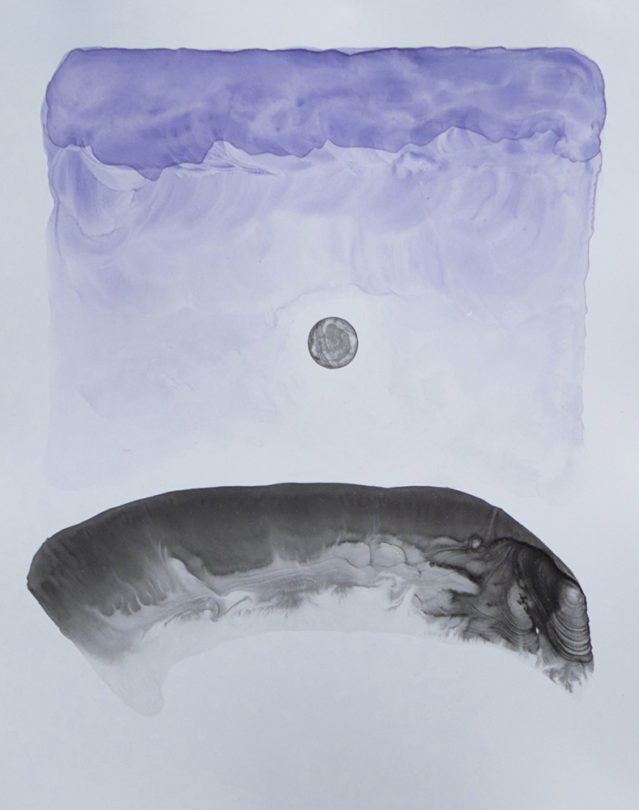
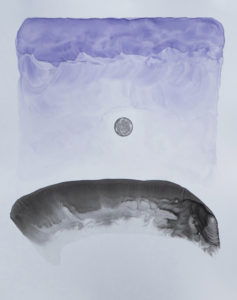
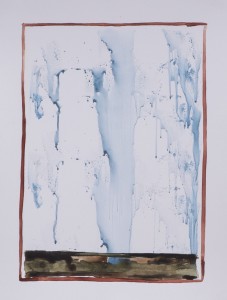 The first image, that of evil, called Abaddon, is dominant and encroaching, seemingly boundless and fearful. The second image is much quieter, gentle but life-giving, boundaried but free. It penetrates the ground rather than taking it over. And it is rimmed by this mysteriously fragile red enclosure. When I made this second image it was after studying some illuminated manuscripts from a book a friend had given me. The first image, as I wrote earlier, took over when I made it, surprised me, troubled me. But it seemed necessary to consider. This second image was planned more carefully, but its making also involved some serendipity. I used a brayer to lay down the veils of blue watercolor, loving the delicate surprise in the markings that resulted, and that were still “in character” with the quiet beauty of good.
The first image, that of evil, called Abaddon, is dominant and encroaching, seemingly boundless and fearful. The second image is much quieter, gentle but life-giving, boundaried but free. It penetrates the ground rather than taking it over. And it is rimmed by this mysteriously fragile red enclosure. When I made this second image it was after studying some illuminated manuscripts from a book a friend had given me. The first image, as I wrote earlier, took over when I made it, surprised me, troubled me. But it seemed necessary to consider. This second image was planned more carefully, but its making also involved some serendipity. I used a brayer to lay down the veils of blue watercolor, loving the delicate surprise in the markings that resulted, and that were still “in character” with the quiet beauty of good.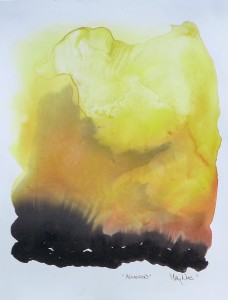 This is an exposure– a hint in a small visual way, of a most difficult concept: the problem of evil. An excellent writer I admire has crafted a brilliant attempt to understand the challenge of real evil. In Unspeakable, Os Guiness says “Modern people have shown a chronic inability to name and judge evil and to respond effectively. . . Evil dwarfs our best discussions and remains a mystery even after our best explanations.”
This is an exposure– a hint in a small visual way, of a most difficult concept: the problem of evil. An excellent writer I admire has crafted a brilliant attempt to understand the challenge of real evil. In Unspeakable, Os Guiness says “Modern people have shown a chronic inability to name and judge evil and to respond effectively. . . Evil dwarfs our best discussions and remains a mystery even after our best explanations.”